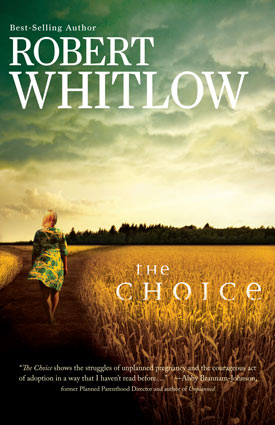 Synopsis:
Synopsis:
Sandy Lincoln has everything going for her. At seventeen, she is a beautiful and popular honors student and cheerleader headed for college and a bright future. But when Brad Donnelly, a charming football player, convinces her to become intimate with him, her life plan is instantly altered. Being a pregnant high school student in tiny Rutland, Georgia in 1974 is scandalous and humiliating — she won’t even be allowed to continue attending the local high school. Worse, Sandy’s parents, Brad’s parents, and even Sandy’s aunt Linda all have ideas about what is best for Sandy and her unborn child. In light of Roe v. Wade, decided just one year earlier, Sandy has many options from which to choose . . . if only the adults advising her would remember that the choice is hers alone, considering that Brad has no interest in being a father and will readily surrender his parental rights.
A chance encounter with an elderly woman leaves Sandy both puzzled and disturbed. The woman tells her that she is carrying twins and the babies must not meet in order to prevent harm from coming to one of them. With no history of twins in her family, Sandy tries to put the woman’s warning out of her mind, convinced that her message was just nonsense. Sandy moves in with her aunt Linda and enrolls in an alternative high school where she continues to excel academically. Ultimately, she selects two families to adopt her fraternal twin boys, convinced that the boys must grow up separately to remain safe and healthy.
More than thirty years later, Sandy is respected and admired high school English teacher and cheerleading coach. She never married or had more children, choosing to contentedly remain in her hometown. When a pregnant student, Maria, seeks Sandy out for advice, Sandy counsels her without revealing her own history. But a turf war breaks out when the school guidance counselor, Carol Ramsey, discovers Sandy’s activities. Soon the school principal admonishes Sandy to let Ms. Ramsey handle the matter. Sandy cannot abandon Maria, who trusts Sandy implicitly, or stand by silently while Ms. Ramsey tries to convince the impressionable and frightened Maria to undergo an abortion. With Sandy’s career, as well as the life of Maria’s unborn child, on the line, Sandy seeks the advice of a bright young attorney, Jeremy Lane.
As Sandy sits in Jeremy’s office, she peruses the family portraits displayed there and is shocked when she recognizes a house depicted in one of them. She saw that same house years earlier when she sneaked a peek inside her adoption case worker’s file. She read the statement submitted by the prospective adoptive mother and saw the photo of the young woman standing in front of that same home. In fact, the information she surreptitiously acquired convinced her to place the younger of her twin boys with that woman and her husband. Jeremy is an adoptee and his mother is well-known for her charitable work with pregnant teenagers. Could it be that all of the choices Sandy has made in her life up to this point have led her back to the child she placed for adoption back in early 1975?
Review:

One of my main goals in writing The Choice was to honor mothers.~ Author Robert Whitlow
But Sandy is in every way a characteristically naive teen-age girl who succumbs to pressure from her jock boyfriend. One sexual encounter leads to pregnancy. As the book opens, Sandy receives medical confirmation of her condition and embarks upon her tumultuous journey. In 1974, abortion had just been legalized and become a readily available option, but Sandy struggles to make the decision that is best for all involved. Whitlow crafts believable characters, Sandy chief among them. A mature young woman, Sandy weighs every possibility, while understandably mourning the life that, no matter what she decides, can never be the same again. If she carries the child to term, remaining with her high school peers is out of the question — pregnant girls were forced to transfer to another school or drop out — and Rutland is a small town where Sandy’s condition cannot remain a secret. Compounding her distress is the prospect of moving away from home until the delivery. Ultimately, Sandy cannot bring herself to terminate her pregnancy and opts to move in with her mother’s unmarried sister, Linda. Whitlow’s depiction of Sandy’s excruciatingly painful election to place her child for adoption also rings true, as do the reactions of the supporting characters, including Sandy’s mother who is devastated at the prospect of not seeing her grandchildren grow up.
The second half of the book is less successful as Whitlow depicts how Sandy’s life intersects with her sons’ lives. The story developments feel contrived and forced, the boys’ acceptance of Sandy and instant willingness to incorporate her into their families too easy. The legal entanglement that leads Sandy to Jeremy for counsel and advice is plausible, but the coincidences strain credulity and disappoint because of their predictability. Whitlow makes a point about faith, divine guidance, and providence, but does so but with less success than he pulls readers into Sandy’s pregnancy dilemma. Had Sandy married and had more children, or encountered hostility from one of her sons or his adoptive family member(s), Whitlow would have given himself more opportunities for interesting and authentic dramatic tension.
Despite those shortcomings, the story remains enjoyable, especially for readers eager for a happy ending. Whitlow succeeds at paying tribute to women who choose to give their child a life in which they will not play a part. “Within the abortion movement, the word choice is a rallying cry for the right of women to terminate a pregnancy as an acceptable form of birth control. In this novel I want to show that the same word can apply to a woman’s decision not o abort her baby. Sandy is unselfishly “pro-choice.” . . . Sandy’s actions at key points illustrate practical ways to redeem the word choice,” according to Whtlow. In that aspect, The Choice is an unequivocal success. A clever final plot twist will bring a smile to and endear even the most cynical reader to Whitlow. The Choice explores a topic that is as timely today as it was in 1974, providing material for debate and discussion. It would also be an excellent choice for young adult readers because of the themes it explores.



1 Comment
Wow. This sounds like a gut-wrenching read. Thank you for the thorough review. This is definitely going on my TBR list. 🙂